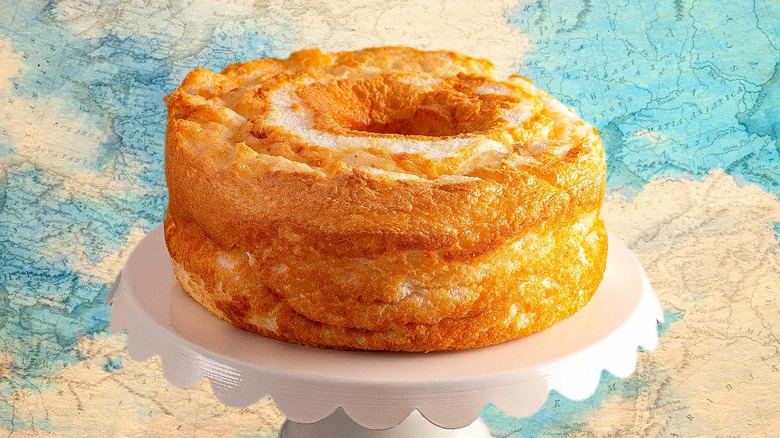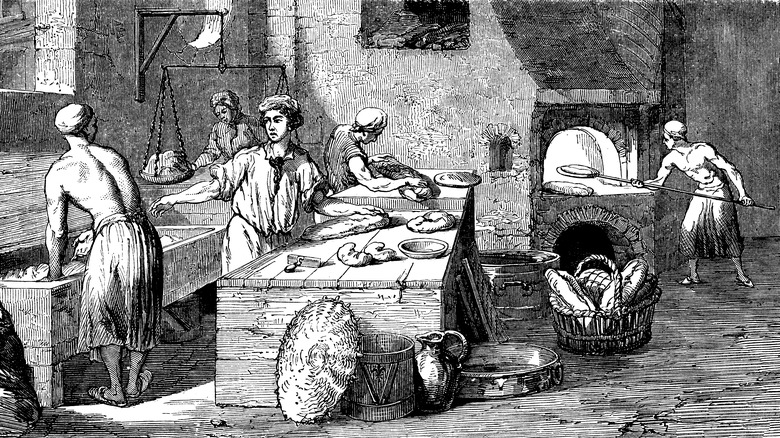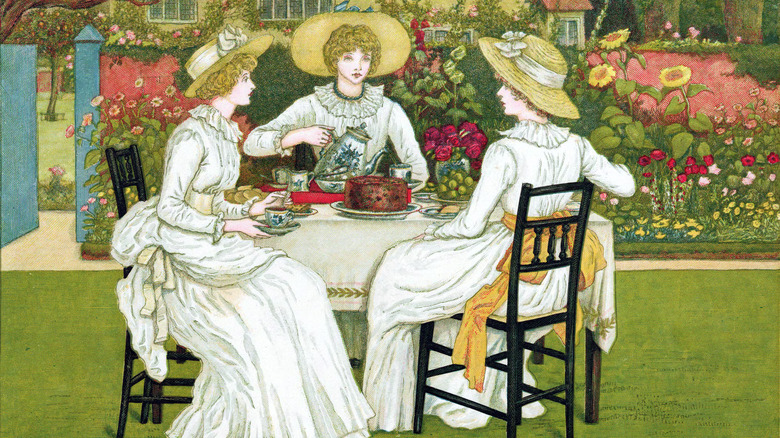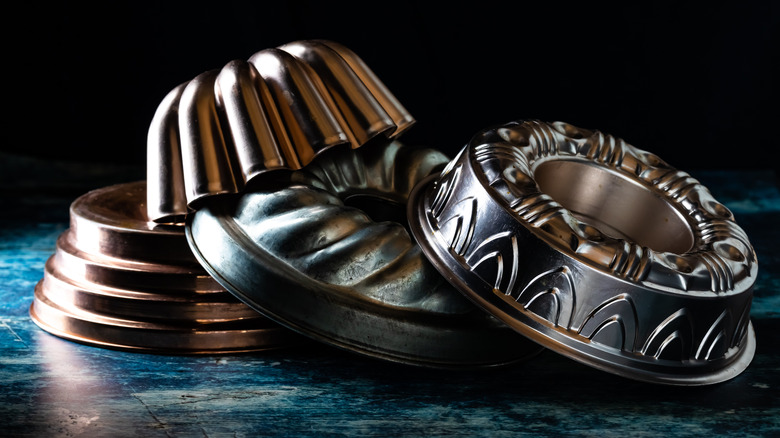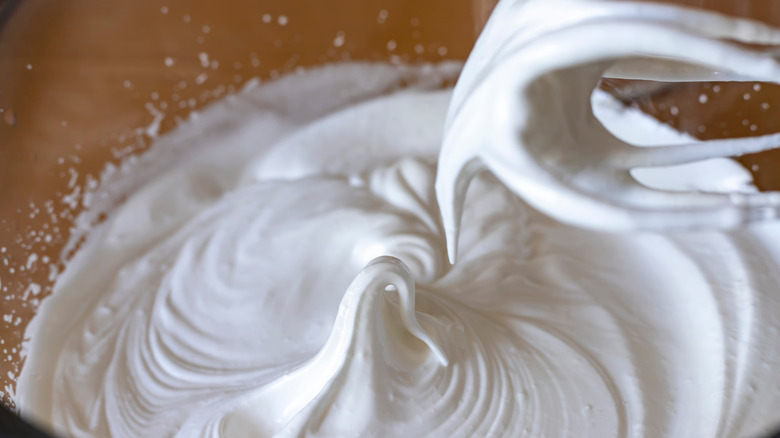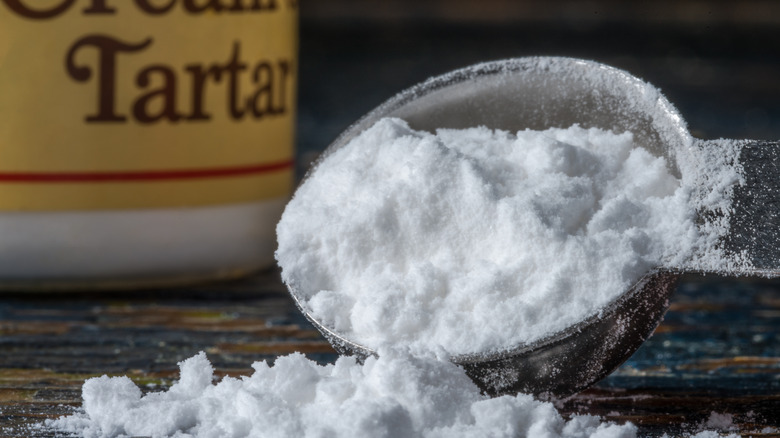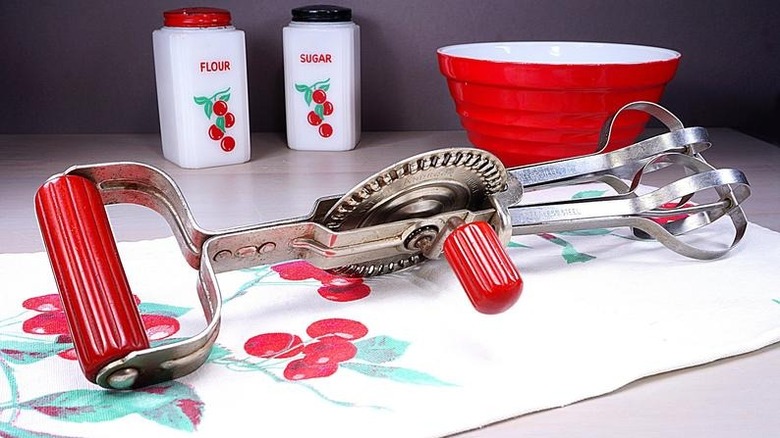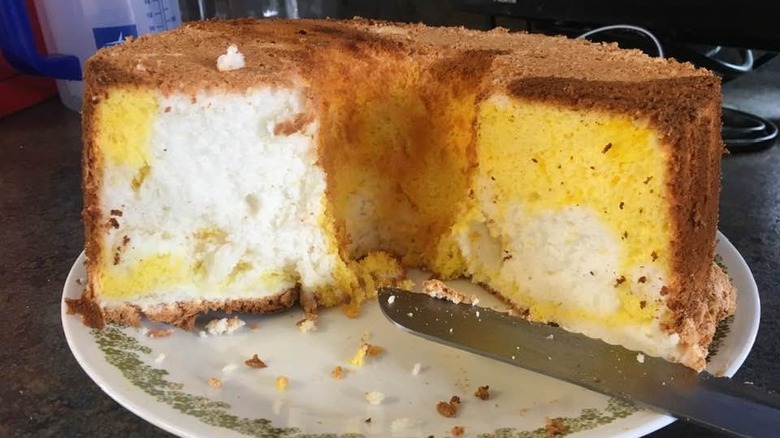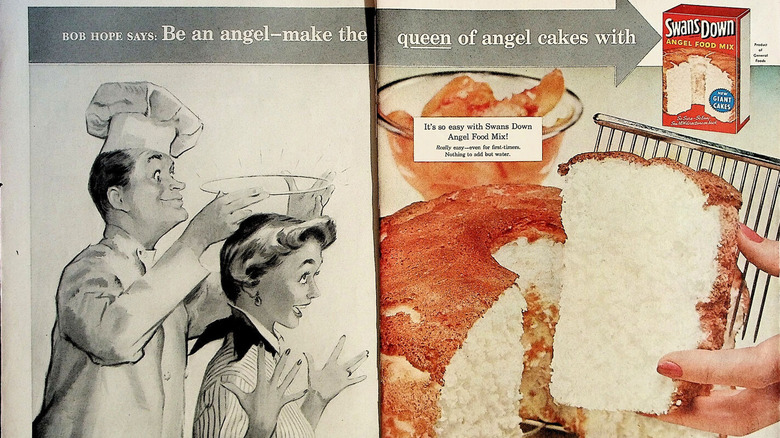The Mysterious Origins Of Angel Food Cake
We may receive a commission on purchases made from links.
With virtually identical recipes appearing under the names of Sponge Cake, Cornstarch Cake, Silver Cake, and Snowdrift Cake, the genesis of Angel Food Cake's name is as mysterious as the origin of the recipe itself. Many have speculated on the heavenly appellation, likening it to the cake's exquisite crumb structure with its emphasis on egg whites. After the whites are beaten to perfection and the cake is in the oven, the batter does, after all, have a rather ethereal quality of rising higher than most desserts in the vague direction of the heavens. As John F. Mariani concludes of angel food cake in the "Encyclopedia of American Food and Drink," "The egg whites give it a texture so airy that the confection supposedly has the sublimity of angels."
As a low-fat, low-calorie dessert, angel food cake persists today as a widely enjoyed treat, a loophole for continuing to enjoy carnal pleasures that still adhere to the restrictions of many mainstream diets. But perhaps somewhat fittingly, when making an angel food cake from scratch, it is easy for us terrestrial beings to botch a recipe at any stage of the process. Zealous bakers should avoid over-whipping egg whites and never skip the step of sifting flour. Once the cake has cooled, slicing it is as much a delicate art as the baking process, but this cake's fickleness has not lessened its widespread allure. No matter where angel food cake originated, its appeal continues to remain timeless and utterly human.
Renaissance Origins and a Regency Title
Angel food cake belongs to a class of baked goods known as sponge cakes, which are distinguished by their use of many eggs (rather than yeast) as a leavening agent, and which were all the rage during the Renaissance. With alleged Italian origins, recipes for this confection were one of many reasons why Italian cooks gained a reputation as superior bakers, which led to many wealthy households in England and France seeking to hire Italian culinary maestros.
Though the process of making sponge cakes may seem complex — the batter requires a great deal of beating to whip air into the mix — traditional recipes only used simple ingredients: Flour, sugar, and (lots of) eggs. With no butter or oil required, sponge cakes were a step above denser desserts and continued to gain popularity in England.
Sponge cake predecessors went by many names — the "Oxford Companion to Food" lists recipes for "fine bread," "bisquite du roy," and "common biscuits" which appeared in various English cookbooks in the early 17th century. But the term "sponge cake" wouldn't emerge for another two centuries, and, as the BBC suggests, may have been coined by Jane Austen. "You know how interesting the purchase of sponge-cake is to me," she says in an 1808 letter to her sister, which is the first written record of the name. Later iterations of this light and airy dessert would become mainstream later in the 19th century with the invention of afternoon tea.
The Victoria Sponge
The concept of afternoon tea arose due to The 7th Duchess of Bedford's hunger pangs. A lady-in-waiting to Queen Victoria, she could not last the inordinate stretch of time between lunch and dinner, a gap that had grown ever-wider with the advent of gas lighting allowing for later nights (and consequently later meals). Around 1840, her request for a snack in the late afternoon — which included tea and cake — became a habit that caught on amongst England's upper classes, and within the next decade even Queen Victoria herself was hosting "tea parties."
The Victoria Sponge, named for the Queen, became a teatime staple — a layer of jam and cream between two rounds of sponge cake. Food historian Alysa Levene writes in her book "Cake: A Slice of History" that Queen Victoria herself was partial to this sponge cake sandwich (often alternatively called the Victoria Sandwich) hence becoming its namesake. The Queen's preference for this dessert was for the cake rounds to have only a simple layer of jam in between. Whether due to the Queen's preference or not, this teatime cake remained highly popular amongst the upper classes, but it was Isabella Beeton's 1874 cookbook, "Mrs. Beeton's Cookery and Household Management" which brought the recipe into middle-class popularity. Simple but delicious, the Victoria Sponge is a cake that appeals to all, and brought to light how versatile the sponge cake could be.
The Sponge Cake Evolves in America
Sponge cakes evolved differently across the Atlantic, and American versions took on their own form. The first American sponge cake recipe appeared in Lettice Bryan's 1839 cookbook, "The Kentucky Housewife." Under the name of White Sponge Cake, it stood out amidst other cake recipes in the publication for its large portion of egg and sugar to a smaller ratio of flour. The original recipe calls for 20 egg whites and a pound of sugar, and was flavored with a mixture of lemon zest and orange juice. The citric acid from the juice stabilized the mixture, allowing for a cake that was light but also structured, with no threat of collapse once it came out of the oven.
It took white sponge over two decades to reach widespread recognition, which came with an updated but simplified recipe in Helen Robinson's Civil War era cooking manual, "The Practical Cook Book" which used only sugar, egg whites, and flour. Food 52 recounts that the 1870s was the era when white sponge truly became popular amongst bakers; newer recipes often added cream of tartar to improve stability and opted for almond extract as a common flavoring. These later versions of the white sponge were essentially angel food cakes being baked under a different name. It wasn't until the publication of Isabella Stewart's 1878 cookbook, "The Home Messenger," that a white sponge recipe was finally called "angel's food."
A Pennsylvania Origin Story
There is much evidence to suggest that angel food cake may have come from Pennsylvania, the biggest clue being that the cake's introduction coincides with the emergence of mass-produced bakeware. Food Timeline reports that the Pennsylvania Dutch introduced the cake mold to America, "a special metal pan for creating festive cakes in unusual shapes." Before molds, the standard tools for cake baking were simple pans or hoops, which limited cake shapes. Cake mold production was centered in Pennsylvania during the 19th century.
Perhaps this was simply a matter of industry meeting innovation, as Pennsylvania was also a center for American aluminum production, culminating in the formation of the Pittsburg Reduction Company, founded in 1888, which would evolve to become the Aluminum Company of America, also known as Alcoa. Aluminum remains the most common metal from which cake molds are made, and angel food cake could never have existed in its present form without the proper cake pan to allow the batter to rise.
Another hint that links angel food cake to Pennsylvania is another local commodity – egg noodles. "Some believe [angel food cake] evolved as the result of numerous egg whites left over after making noodles," Evan Jones writes in "American Food: The Gastronomic Story," "[which] may or may not be the brainchild of thrifty Pennsylvania cooks who considered it sinful to waste anything." Further evidence points to Pennsylvania with a version of angel food cake referred to as a Pennsylvania Dutch wedding cake.
A Recipe Requiring Slave Labor
Irrespective of who first conceived and consumed recipes for angel food cake, historians suspect that African American slaves were the first people to bake this dessert. They may even have been enslaved people residing in Pennsylvania, since the Pennsylvania Dutch themselves did participate in the slave trade. Though the state attempted to abolish slavery in 1780, many Black people in Pennsylvania remained in bondage well into the 19th century.
Before innovations in kitchen appliances that would revolutionize home baking at the end of the 1800s, the vast quantities of egg whites that define angel food cake recipes had to be whipped by hand, requiring a strong pair of arms for the job. For this reason, it is likely that enslaved workers would have been tasked with the heavy work that went into producing such a light dessert.
The minimal ingredients that combine into angel food cake may also be evidence that slaves themselves created or adapted the recipe, as they were not given easy access to the prized butter or egg yolks that went into baking denser, more traditional cakes. Consequently, angel food cake could have been a creative means of adapting limited (and even leftover) resources into a unique confection. In any case, angel food cake went on to become a traditional dessert served at African American funeral feasts.
False Claims of a St. Louis Baker
With a snazzy new name, angel's food cake — though still the same white sponge — reached widespread renown at the end of the 19th century. Though white sponge forebears had already existed in American cookbooks for decades, angel food was strangely credited in the 1890s to one specific baker in Missouri.
"[Angel food cake] originated in St. Louis a few years ago and is seen oftener in the hotel bills of fare of that city than anywhere else," Jessup Whitehead summarizes in his 1894 book, "The American Pastry Cook." He attributes the cake to one S. Sides, and recounts that the dessert "soon came into such demand that not only was no fine party supper complete without it but it was shipped to distant cities, orders coming even from London."
Considering the female authors Lettice Bryan and Helen Robinson had conceptualized angel food cake prototypes long before, it is highly improbable that Sides truly merited any claim to the invention of angel food cake. Sides did, however, trick many into believing that the cream of tartar in his recipe was some mysterious "certain powder" that only he could make, which may have contributed to the (albeit false) presumption that he conceptualized the cake recipe itself. Curiously, as Whitehead concludes of the dessert's "inventor", shortly after allegedly introducing angel's food, Sides was sent to an insane asylum, leaving his wife to continue his baking business without him.
Popularity Rises with the Rotary Beater
Though angel food cake may have been widely enjoyed, it was not necessarily widely made at home during its early days. The further expansion of the cake's popularity into the turn of the 20th century was largely due to an invention that made beating egg whites a much simpler task, ensuring virtually anyone could do it.
The first rotating egg beaters appeared in the 1860s, but the design was improved upon by Willis Johnson, who patented the rotary beater in 1884. Initially intended to be an all-purpose mixing machine, Johnson's rotary beater turned out to be uniquely suited to beating eggs. This tool, which only required simple hand-winding, eliminated the need for excessive time and exertion that previously went into whisking the batters for many complex desserts — among them angel food cake. Equally good for mixing eggs and batters, Johnson's device was an analog precursor for the electric hand mixer that remains a widely recognizable tool today. Electric mixers began appearing in households across America in the 1920s, which may have helped set the stage for an angel food cake resurgence in the following decades. Paired with Cale J. Schneider's cake breaker, a strange-looking baking tool that emerged in the 1930s, it became easier than ever to mix, bake, and serve flawless angel food cake.
Daffodil Cake
Though angel food cake may have originated as a means of finding a use for egg whites, its rising popularity created a reversal of leftover ingredients. With egg whites taking precedence in the 20th century for this widely renowned recipe, an abundance of egg yolks risked being wasted if they could not be quickly used for another purpose. Finding what to do with leftover egg yolks was never really a point of concern, as there are numerous yolk-centric dishes that are easy enough to whip up (custard, mayonnaise, and carbonara, to name a few). But during the 1930s and '40s, when "waste not, want not" was the ideology of the moment, newfound cultural resourcefulness inspired creative uses for such ingredients, prompting a new version of angel food cake.
Rather than reserving the leftover yolks for a separate purpose, the daffodil cake sought to incorporate them into the angel food cake batter. The egg yolks get whipped into a separate yellow batter that then gets swirled in with the white angel food. The result, once baked, is a marbled angel food cake of gold and white that suggests the colors of springtime daffodils. The recipe was popularized in publications such as the "Woman's Home Companion Cook Book," which helped to bring this take on angel food cake into the mid-century mainstream. Though perfectly delicious plain, various recipes for daffodil cake are differentiated with added flavorings – lemon is a favored choice to pair with the yellow swirls.
A Mid-Century Revival
"Angel food cake, always a favorite in every home, but forever a headache to the homemaker, finally has caught up with the crowd," Mary Ellen Wickes wrote in a 1950 review of the latest angel food cake mix for the Los Angeles Times. Beginning in the 1940s, the invention of a prepackaged mix for angel food cake took all the hassle out of the baking process. EZY Angel Cake Mix, the original, was marketed as a perfectly acceptable substitute for an angel food cake made from scratch. Though bakers and consumers may have been skeptical at first, the convenience of pre-portioned ingredients won out over any suspicion of a quality outcome, furthering angel food cake's popularity through a renaissance of near-instant gratification — the ease of the cake mix meant anyone could bake it at any time.
Operating out of Atchinson, Kansas, EZY Angel Cake Mix quickly inspired a rise of competing brands that migrated beyond the Midwest to find equal favor on the West Coast. "It has won wide approval of Los Angeles homemakers," said a later 1950 review of an angel cake mix for the Los Angeles Times written by Marian Manners (the pseudonym for the publication's food experts). "Everyone who tries it is surprised by the cake's delicate flavor and good texture."
